|
Sponsored by the
University Archives, Iowa State University Library
Copyright 2006
|
|
1858 |
|
The Iowa State Agricultural College is founded on March 22 when
Governor Ralph P. Lowe signs a bill to establish a State
Agricultural College and Model Farm, "which shall be connected with
the entire agricultural interests of the state." An appropriation of
$10,000 is made for the purchase of land and improvements, and a
board established to purchase a farm and establish the college.
The following subjects were to be taught: natural philosophy,
chemistry, botany, horticulture, fruit growing, forestry, animal and
vegetable anatomy, geology, mineralogy, meteorology, entomology,
zoology, veterinary anatomy...."and such mechanic arts as are
directly connected with agriculture."
By Louis Bernard Schmidt, Dept. of
History and Government (1929)
 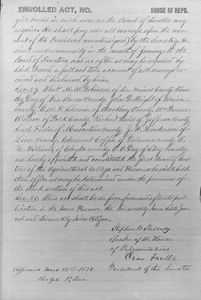
State of Iowa Legislative Act 91, 1858
|
|
1859 |
The Board of Trustees is organized in January and it selected Story
County as the site of the new Agricultural College on June 21. A
picnic on the site is held on July 4 to commemorate the occasion. Suel Foster
is elected first president of the Board of Trustees, a position he
holds until 1865. An early and persistent champion of industrial
education he helped to draft the original bill which was introduced
in the Sixth General Assembly in 1856. Two years later this bill in
revised form became the organic act of the Iowa State Agricultural
College and Model Farm. The original college farm of 648 acres is purchased from five different owners at a total cost
of $5,379. Story and Boone counties pledge private subscriptions,
bonds, and land gifts valued at $21,355.
|
|
1860 |
|
An attempt is made in the Legislature to
repeal the act providing for the establishment of the College. It is defeated largely
through the efforts of legislator Benjamin G. Gue, who was one of
the framers of the original act.
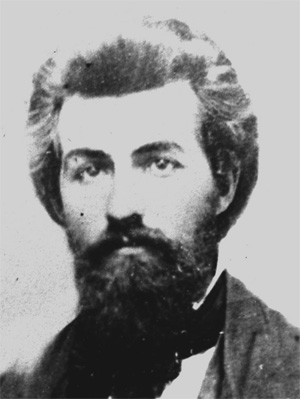
Benjamin G. Gue |
|
1861 |
The Farm House and accompanying Cattle Barn
are completed by local builders. The first occupant of the Farm
House is W.H. Fitzpatrick, who rents the farm in 1861. The Farm
House is the home of the superintendent of the Model Farm and in
later years, the deans of Agriculture, such as Seaman Knapp and
"Tama Jim" Wilson. In 1966, the house is placed on the National Register of Historic Places and
currently serves as a campus museum showcasing the late 19th and
early 20th centuries.
|
|
1862 |
The Federal Land Grant College Act (named the Morrill Act for
Vermont Senator Justin Morrill) of July 2 is signed by President
Abraham Lincoln, providing grants of land and land scrip to the
states in furtherance of instruction in agriculture and mechanic
arts. On September 11, the Iowa legislature officially accepts the
provisions of the Morrill Act, which brought to Iowa the honor of
becoming the first state in the U.S. to do so.
|
|
1863 |
Report of the Office of the Secretary of Iowa State Agricultural
College and Farm
|
|
1864 |
While
the legislature briefly considers awarding the land-grant to the
State University, this issue is resolved on March 21 when
the Legislature votes $20,000 for the erection of a college building
for the Agricultural College in Ames by October 1, 1865. The
Agricultural College thus becomes Iowa's land grant college.
|
|
1865 |
The
legislature appropriates $91,000 for the College, and the act is approved on April 2. The Planning Committee then commences planning the structure of the college: president, faculty, the
subjects to be offered, a system of instructive farm labor, and
admission requirements.
|
|
1868 |
 Academic life: Academic life:
Adonijah Welch is appointed the first
President on May 11. Trained as a lawyer, he had been the first principal of
the Michigan State Normal School. At the time of his appointment he is living in Florida and had been elected
to fill out an unexpired term in the U.S. Senate.
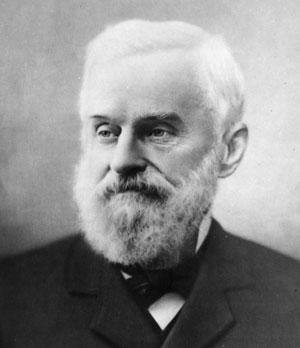 |
Adonijah S.
Welch |
| |
|
 Campus: Campus:
The first unit of the Main Building (Old Main), predecessor of Beardshear
Hall, is completed at a cost of $10,570. The building contains a
reception room, library, lecture hall, a specimen museum, professors' and
recitation room, students' rooms, a chapel, kitchen, laundry, and dining
room as well as rooms for the housekeeper and maids.

Old Main, n.d.
 Student life:
Student life:
A preparatory class of seventy men and women students is received on
October 21, making Iowa State coeducational from the beginning.
The Philomathean Literary Society is founded for both men and women
and by 1873, there are 50 members. Originally meeting in the
chapel, they later establish a long-term home in the Freshman Room
of Old Main, and the group is chaired by Professor T.S. Townsend, instructor
in agriculture and zoology.
 University: University:
Known as the Iowa Agricultural College,
the college is often identified by its initials, I.A.C.
|
|
1869 |
 Academic life: Academic life:
Iowa State Agricultural College is formally
opened for the admission of students on March 17. The Main Building is also dedicated and President
Welch inaugurated. Curricula in agriculture and mechanic arts are offered. In the first term, classes
are taught in rhetoric, landscape
gardening, German, algebra, arithmetic, bookkeeping, geography, analysis,
and instrumental music.
 Campus: Campus:
Three "professors" houses are constructed:
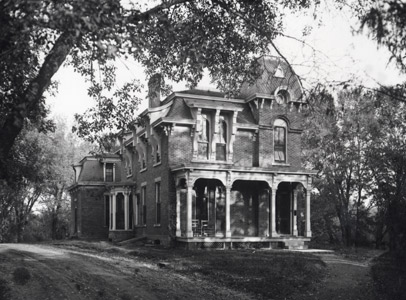 |
South Hall (also known as South Hall, Domestic Economy
Hall, and Music Hall): This residence serves as a home for
President Adonijah Welch and stands south and east of the
Campanile. Later known as South Hall, Domestic Economy Hall,
and Music Hall, it is destroyed by fire in 1912. |
| South Hall, n.d. |
|
| |
|
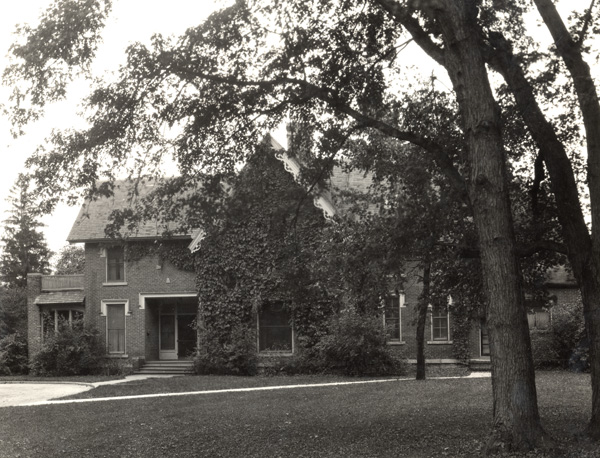 |
Music Hall (also known as
"The Maples" and "Stanton House"): The house known as
"The
Maples" is erected for Professor George W. Jones. Long the
home of Edgar Stanton (Class of 1872) and professor of
mathematics until his death in 1920, it then housed the
Music Department until it is
razed in 1978.
|
|
Music Hall, 1923 |
|
| |
|
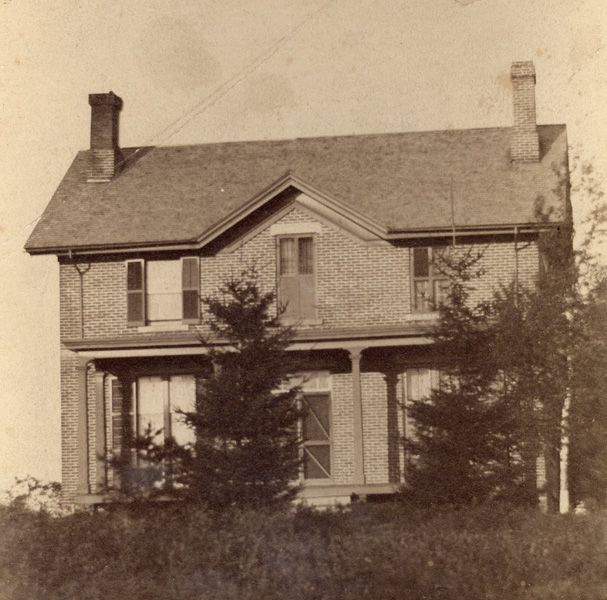 |
Marston Cottage is first
occupied by Professor William A. Anthony until he resigns in 1872. The house
is named for Anson Marston, Dean of Engineering, who resides there
from 1892-1949. His widow continues to live there until it
is razed in 1958. |
| Marston Cottage, n.d. |
|
 Student
life: Student
life:
The first class is comprised of 173 students, 136 men and 37 women. They
enrolled from 55 Iowa counties.
 University: University:
Benjamin Gue (former lieutenant governor of Iowa, and
president of the Board of Trustees) states in his inaugural address:
"Who of us can foresee the future of this Institution, which we this
day dedicate to the education of the working people of Iowa?
It needs no prophet to foretell that its influence upon the youth of
these classes, must in no very distant future be felt far and wide.
We may not live to see this day, but the time will surely come in
which graduates of the Iowa Agricultural College will be found among
the most eminent men and women that our State or this country can
produce....inculcating correct principles, pure morals, free from
prejudice, bigotry and false pride, they cannot fail to attain the
highest positions of honor and trust....and by their lives honor the
institution to whose fostering care they are so indebted."
Addresses Delivered at the Opening of the Iowa State
Agricultural College, March 17, 1869, p. 15
|
| 1870 |
 Academic life: Academic life:
President Welch and I.P. Robert,
professor of agriculture, hold 3-day farmers' institutes at Cedar
Falls, Council Bluffs, Washington, and Muscatine. These are the earliest institutes held
off-campus by a land grant institution, and were the forerunners of
20th century extension.
 Campus: Campus:
The first part of the Chemical
Laboratory is built at a cost of $5,003. The North Farm of 140
acres is purchased for $3,500
(where the former Pammel Court and the current Veenker Golf Course
are now located). President Welch also requests legislative
funding for a 2-wing expansion of Old Main.
 Student life:
Student life:
Two additional literary societies are formed, The Bachelors'
Debating (which allowed only male members) and the Crescents, which
had thirteen original charter members. This original thirteen
includes Edgar Stanton (professor and first to receive an I.A.C.
diploma), Millikan Stalker (professor of Veterinary Medicine), and
LaVerne Noyes (who donates the funding for Lake LaVerne).
The rules of the College are fairly strict, and included the following
examples: 1. The recitation hours of the day and hours of the
evening from 7:00 p.m. till 10:00 p.m. (except Saturday and Sunday)
are set apart as study hours. 2. During study hours all students
except such as are detailed for work, shall study quietly in their
rooms. 4. Lights shall be extinguished at 10:00 p.m.
7. Loud
talking, whistling, scuffling, gathering in hall or stair cases, and
boisterous and noisy conduct, are at all times forbidden.
12. Students shall be detailed for labor by the President, and shall
work as directed an average of two hours and one half per day for
five days in the week. (Young women worked in the dining or
laundry services; young men on the farm. Equal wages for both
men and women were to be paid, as directed by President Welch.
14.
Students may not visit the dining-room, laundry, kitchen, bakery,
store-room, cellar, ice-house, workshop, or barns, nor walk through
the meadows, lawns, or growing crops, without special permission.
15. The use of intoxicating liquors is prohibited to members of the
College.
 University: University:
Donations to the College include one hundred rhubarb roots, an
industrial plow, an American bee hive, monthly reports from the
Department of Agriculture, and geological specimens.
|
|
1871 |
 Academic life: Academic life:
The following
classes are taught in Chemistry: inorganic chemistry, organic
chemistry, quantitative analysis, theoretical chemistry, qualitative
analysis, agricultural chemistry, and physiological chemistry.
President Welch teaches classes in landscape gardening, the study of words,
rhetoric, and analysis.
The College Herbarium (now the Ada Hayden Herbarium)
is established
by Charles E. Bessey, professor of botany. A herbarium is a
plant library containing dried and pressed plants. The
Herbarium, in 2006, contains 640,000 specimens of flowering plants,
conifers, ferns, mosses and liverworts, algae and lichen, grasses
and legumes.
 Campus: Campus:
Two wings are added to Old Main at a cost of $47,455.
The College also constructs a workshop, chemical laboratory, a horse
barn, a professor's house, a corn crib and hen house, and a root
cellar.
In examining the College's budget, it is discovered that an excess
of $19,073.77 has been spent on the College building (Old Main) for
lighting, heating, and supplying water.
While the main object of
the campus garden is to serve as a means of illustration, the
produce raised provide supplies for the College, Farm House, and
professors' families. The crops raised were beans, beets,
cabbages, carrots, corn, cucumbers, lettuce, melons, onions,
parsnips, peas, potatoes, radishes, salsify (a vegetable whose root
and leaves can be used for cooking purposes. It is also known as
white salsify, goatsbeard, vegetable oyster, and the oyster plant,
PageWise.com), squashes, turnips, and tomatoes. 79
varieties of potatoes are also planted.
 Student life:
Student life:
To enter Iowa
State College as freshmen, students must pass examinations in grammar, spelling, geography, arithmetic, and algebra. Some sample questions:
1.
Name and define all parts of speech
2.
Name in order of size the 3 largest rivers in the world
3.
Divide 365729 by 365
4.
If 4 men in 6 days cut 36 cords of wood, in how many days will 9 men
cut 27 cords?
Excuses for any
absences from any college exercise must be granted personally by the President through a
personal application from the student.
The Sunday schedule for students:
7:00 a.m.:
Prayers
9:00 a.m.:
Bible History
11:00 a.m.: Singing
3:00 p.m.
Preaching
7:00 p.m.:
Students' Prayer Meeting
Students are only required to attend
prayers and the 3:00 service.
 University:
University:
Donations to the College for 1870 and 1871:
Rhubarb roots, garden seeds, mowers, plows, a bee hive, quartz
geodes, a copy of the Dubuque Daily Times, and cattle portraits.
Farmer's
Institutes are held at Cedar
Falls, Council Bluffs, Washington, and Muscatine, involving several
hundred farmers. The program topics include beef animals,
fruit culture, stock breeding, bee culture, the milch cow, and
agricultural education.
The Library
contains 2,400 volumes (and
spends $1,244.01 on new books).
|
|
1872 |
|
 Academic life: Academic life:
The first
courses are given in domestic economy (home economics, family and
consumer sciences) and are taught by Mrs. Mary B. Welch, the
president's wife. Iowa State becomes the first land grant university in the
nation to offer training in domestic economy for college credit.
The first courses in Veterinary Science during the fall term
are taught by Dr.
Henry H. Detmers. A course on the management of bees, taught
by Mrs. Ellen Tupper, is also offered.
The Herbarium contains 2,500 specimens, and also
displays a grains
and textiles collection from the Paris Exposition of 1867.
 Athletics:
Athletics:
The
popular sports are baseball (for men) and croquet (for both men and women).
While Iowa Agricultural College (I.A.C.) does not play other schools
in baseball, they do occasionally play town teams.
 Campus: Campus:
$45,000 is appropriated
for a general laboratory building by the State Legislature.
The President's
salary is raised to $3,500, and due to the isolation of the College,
he is also allowed a residence.
 Student life:
Student life:
The freshman class
schedule consisted of campus labor from 7 a.m. till 10 a.m., study
time from 10 to noon, classes beginning at 1:30 through 5, and the
evening was for studying. Chapel was compulsory, and any
absence resulted in 3 demerits.
 University: University:
A total of 106
swine are
owned by the College: 38 Berkshires, 36 Chester whites; 2 Poland
China, and 30 cross breeds.
The Library's
collections are particularly strong in architecture, physics, natural history,
and agriculture.
26 students graduate in the first class: 24 men
and 2 women. The first commencement is a great event (held at
West House in Ames), beginning in the early afternoon and lasting
till late in the evening, ending with a supper. Each graduate
delivers an oration and many people attend from throughout the
state. President Welch also speaks (his address is on display
in Special Collections, 403 Parks Library, for the
Sesquicentennial).
Graduate Mattie Locke states in her commencement
speech, “The world must learn that in woman's heart there are longs
for better things. We want it understood that we are neither dolls
nor drudges, but participants in a common humanity.” |
|
1873 |
|
 Academic life: Academic life:
The classes taught
include landscape gardening, architecture, field artillery,
analysis of the English sentence, German, mechanical drawing,
constitutional law, stock-breeding, and algebra.
C.P. Wellman (Class
of 1872) registers as the first graduate student. J. K. Macomber
(Physics) and Edgar Stanton (Mathematics), both of the Class of
1872, joins the faculty.
 Campus: Campus:
The Chemical
Laboratory is furnished with furnaces, sandbaths, hoods, balances,
filter pumps, and other apparatus for the Chemistry classes.
 Student life:
Student life:
The
literary magazine, the Aurora, is published monthly by the
students for the four literary societies on campus (The Philomathean
(1868); The Bachelor (1870); the Cliolians (1870) and the Crescent
(1870)). The cost of a year's subscription is $1.00 and a single
issue cost $.15. The Aurora contains essays, reviews, and
musings relating to culture, reading, and science, as well as local
notes relating to alumni, the campus, and student activities and
life.
The
college terms runs from March through November.
Oyster
suppers are in vogue. Pies baked by the night watchman's wife
are
also available for purchase.
 University: University:
An investigation is
undertaken of Major Samuel E. Rankin, who is serving as the
College treasurer (as well as the State Treasurer). Some $38,000 of
College funds have been appropriated to cover drafts. College
officers are absolved of any wrongdoing. Rankin turns over enough
of his personal property to cover the loss.
The
University motto, "Science with Practice," is first used.
The
Class of 1873 includes 11 gentlemen and 4 ladies for a total of 15
graduates. Their commencement supper is held at the Waring House
in Nevada. President Welch also gives a presentation.
|
|
1874 |
|
 Academic life: Academic life:
President Welch teaches landscape gardening, psychology, political
economy, and stock-breeding. There are 263 students enrolled in
the college.
 Athletics:
Athletics:
Baseball is very popular, and there are numerous games played
between the Iowa Agricultural College (I.A.C.) classes, resulting in
sprained and broken fingers, one dislocated jaw, and some smashed
teeth (according to the Aurora).
 Campus: Campus:
The
telegraph is extended to Ames and to the College.
 Student life:
Student life:
Croquet
continues to be played on campus, and during the summer, many are
out at night to go comet-watching.
 University: University:
Edgar
Stanton is appointed Secretary of the Board, and in conjunction
with the College Treasurers (including Major Geddes and Herman
Knapp) keeps close watch over the College's financial affairs.
Stanton serves in this position until 1909.
|
|
Time line, 1875-1899 |
|
